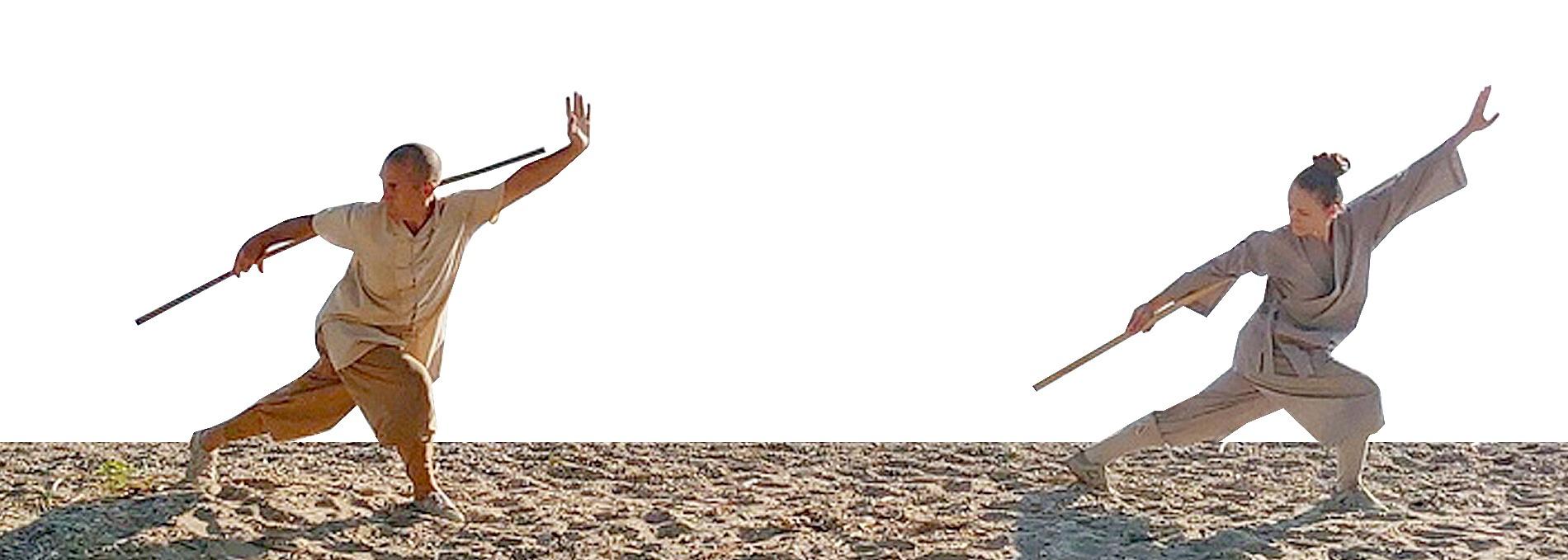While mountain temple is globally famous, other cultural attractions are also gaining foothold
 Form left: A performer demonstrates moves at the Shaolin Zen Music Ritual performance; two students practice martial arts at Chanxinju Homestay. (LU PING / CHINA DAILY)
Form left: A performer demonstrates moves at the Shaolin Zen Music Ritual performance; two students practice martial arts at Chanxinju Homestay. (LU PING / CHINA DAILY)
Fourteen years ago, Australian cancer sufferer David Ian Burn visited Songshan Mountain in Henan province to learn Zen techniques to try and improve his chances of beating the disease.
While the area is famous around the world for Shaolin Kung Fu, it is also becoming known for other cultural aspects including Chan Wu Yi, which combines Zen meditation, kung fu and traditional Chinese medicine, and has been promoted by Master Shi Dejian for 30 years.
In 2010, Burn stayed for two weeks on the steep mountain and learned about Chan Wu Yi from the master.
"This time was really important to my recovery," said the Australian, now aged 72. "His (Shi Dejian's) counsel and support enabled me to go into the hospital well-prepared, confident and relaxed. He also provided me with some herbal medicine, which was very useful to me after the surgery."
Since then, Burn has continued to live as a vegetarian, and still practices Chan Wu Yi.
"Practicing internal cultivation has become a normal part of our lives, and it can be said that Chan Wu Yi is our basic way of life. I am grateful for the connection with the masters and their continuous kindness," he said, adding that he is writing a book to provide an understanding of Chan Wu Yi culture to more Westerners.
Stretching from east to west for over 60 kilometers, Songshan Mountain is eulogized in folklore as the "origin of all mountains "and according to ancient script has "72 peaks on the mountains and 72 temples below".
READ MORE: Embracing kung fu without borders
Its spectacular, well-preserved angular rock shapes were formed by three violent movements in the earth's crust, the most recent 570 million years ago, when the Himalayas and the entire Qinling Range were submerged under the sea.
However, it is the 1,529-year-old Shaolin Temple, nestled in a mountain forest near Dengfeng, and its style of kung fu that has left the biggest impression on the world. Today, 162 Shaolin cultural centers have been established in over 50 countries and regions, while the Shaolin Temple attracts nearly 7 million Chinese and international tourists and martial arts enthusiasts every year.
But located 8 km from the temple is Songshan Buddhist Academy, the main practice center for Chan Wu Yi. Chan means Zen, Wu means kung fu, while Yi means medicine.
In 1994, Master Shi Dejian, under the guidance of his mentor, initiated the restoration of the academy's dilapidated buildings to help promote Chan Wu Yi. Eleven years later, the Songshan Chan Wu Yi Research Institute was established near Songshan Buddhist Academy, with Shi Dejian serving as its director.
 A view of Songshan Buddhist Academy in Henan province. (PROVIDED TO CHINA DAILY)
A view of Songshan Buddhist Academy in Henan province. (PROVIDED TO CHINA DAILY)
Shi Xingjia, a disciple of Shi Dejian, said the institute also operates an official website to provide free public education on Chan Wu Yi culture, which has attracted nearly 1 million followers.
Chen Ruiyan, a professor and clinical psychologist at the Chinese University of Hong Kong who specializes in the brain and nervous system, is one of Master Shi Dejian's disciples. She has set up a research team that has found indications that practicing dan tian breathing enhances brain function, and eases emotional, sleep and gastrointestinal problems.
"The practice of dan tian breathing is the foundation of Songshan internal cultivation, the basic method of Shaolin Chan practice, and is also a good way to improve people's psychological and physical condition," Chen said.
She has been practicing Chan Wu Yi for over 10 years, and her research results have been published in several international academic journals. Chen has also written two books on the subject — The Way of Mind Peace and Dejian Mind-Body Therapy.
Songshan Buddhist Academy has established an ecological health culture base at Lingnan Chan Temple in Luhe county, Shanwei, Guangdong province, to provide information on Chan Wu Yi culture to the public.
Largest live stage
Every evening from late February to early December, in Daixiangou, 7 km from Shaolin Temple, a large-scale live-action performance captivates thousands of tourists from home and abroad.
The Shaolin Zen Music Ritual performance takes place deep in a canyon surrounded by slopes, streams, waterfalls, bridges, boulders, trees and temples.
The performance area covers nearly 3 square km — with the highest point 1,400 meters above sea level — making it one of the largest live stages in the world. The audience members sit on 3,000 cushions provided for them.
The show mainly focuses on Shaolin history, culture and martial arts, and incorporates traditional Chinese music, chess, calligraphy and painting. Eighty-eight traditional zithers are used in the show and nearly 600 martial artists participate. The performance depicts the seasonal changes of spring, summer, autumn and winter, to the accompaniment of Buddhist music.
"We need to find a new way to showcase the charm of Songshan Mountain to the world, breaking away from the monotonous tourism concept of 'climbing mountains and visiting temples'," said Zhou Dingjun, the deputy general manager of the show.
Most of the performers are students from martial arts schools and professional dancers from art schools, along with some local theater troupes and part-time actors.
 The heads of the St. Petersburg Shaolin Culture Center practice their moves in the Russian city. (PROVIDED TO CHINA DAILY)
The heads of the St. Petersburg Shaolin Culture Center practice their moves in the Russian city. (PROVIDED TO CHINA DAILY)
Homestay havens
In Yangjiamen village, 5 km from Shaolin Temple, residential courtyards with old brick and mud walls, small bridges, flowing water, and scattered rocks, trees and fields create a picturesque rural landscape.
In 2018, Yangjiamen was listed in the fifth group of China's traditional villages.
Much of the village is now Chanxinju Homestay, or Zen Mind Homestay. Chanxinju has established a traditional cultural study center that integrates food and lodging, Shaolin Kung Fu and a rural lifestyle. It has also co-founded the Qingnong School (Songshan Mountain) Rural Development Research Institute in conjunction with Tsinghua University.
Liu Shaoli, manager of Chanxinju, said before 2011 it was a desolate and abandoned village. Due to its location in a hollow of the mountain and inconvenient transportation access, the villagers had gradually moved out and left behind the dilapidated old buildings.
The founder of Chanxinju, Lu Hailong, is from a rural family in Liyang, Jiangsu. Lu spent over 10 years repairing the old village houses with the idea of preserving the past for future generations to enjoy.
The first completed courtyard, Chongshan Academy, began operations in 2014, offering enrollments to students from Lu's martial arts school and organizing a series of traditional cultural experience courses and summer and winter study programs. The renovated buildings opened in 2018, with 13 guest rooms for visitors.
"The interiors feature simple Zen-style modern facilities, along with a vegetarian restaurant, a cafe, and a camping and barbecue area, attracting many young people from nearby cities such as Zhengzhou and Luoyang to visit, take photos, experience nature, and enjoy the quiet and old-style rural life," said Liu, the manager.
Historically, the village was an important stop on the way to Shaolin Temple and Luoyang, she added. "The village has a long history, and there are many ancient trees and buildings around it worth exploring. It is even more beautiful on rainy days when the mountain villages are shrouded in clouds, it's like a fairyland," Liu said.
During long holidays like Spring Festival, Chanxinju receives many tourists from across the country. Every summer, Lu Hailong's foreign martial arts disciples bring their friends who love Shaolin Kung Fu to study in the village, said the founder.
Russian disciples
While changes are happening on the ground, Shaolin culture is also strengthening its foothold overseas.
In January, Russian Oleg Gizatullin, or Shi Yanfu by his monastic name, returned to Shaolin Temple to participate in a Shaolin Kung Fu examination. The 56-year-old has practiced kung fu for more than 30 years.
Gizatullin was accompanied by his 36-year-old wife Svetlana Vsemirnova, or Shi Yanbin, who has practiced Shaolin Kung Fu for 13 years. The pair have established the St. Petersburg Shaolin Culture Center at a sports school in St. Petersburg, which currently has over 30 students.
ALSO READ: Foreign guests appreciate the charm of Chinese culture
"Every morning we practice Shaolin Kung Fu by the banks of the Volga River, starting with qigong and meditation," Gizatullin said.
Vsemirnova, who spent four years studying at the Harbin Institute of Technology and is fluent in Chinese, said Shaolin Kung Fu culture has helped her spiritual cultivation. She said everyone encounters different issues and finds their own way to heal themselves.
"Since the outbreak of the COVID-19 pandemic, practicing qigong regularly has been greatly beneficial in improving our lung and heart functions, enhancing our immunity and alleviating anxiety caused by the pandemic," Vsemirnova said.
"Now, every friend around us has been influenced by Shaolin culture. They come to us for help when facing problems, and we teach them qigong to relieve depression and stress, promoting self-cultivation."
She said she hoped to eventually live in Dengfeng for a lengthy period and further her studies of Shaolin culture.


